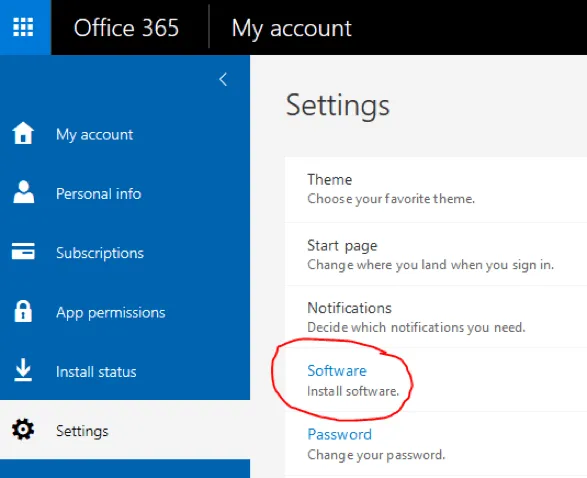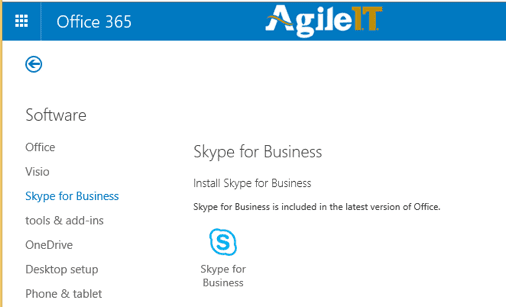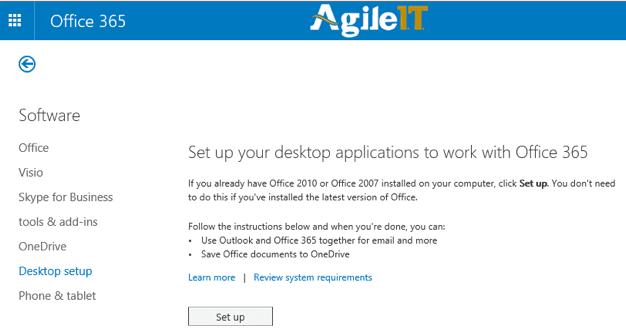Install Office 365: Configuring Workstations
Youve purchased Office 365 licenses Now you need to install Office 365 and configure user workstations Fortunately Autodiscover automates many of ...

You’ve purchased Office 365 licenses. Now you need to install Office 365 and configure user workstations. Fortunately, Autodiscover automates many of these processes. Whether you’re an admin or user, read on to learn how to install Office 365 applications and licenses and configure workstations using Autodiscover.
Getting Started With Office 365
If you don’t know which Office 365 license you have, check with your network administrator. Depending on your license, follow these steps:
- E3 and Business Premium license holders: Confirm you will be installing Office 2016 to your computer. Follow the instructions for “E3” not “E1.”
- E1, Business Essentials, Email Only license holders (or those not installing Office 2016 to your computer): Follow the instructions for “E1” not “E3.”
The objective is to set up PC desktops for Office 365. Here’s the road map covered below:
- Connect to the Office 365 Web Portal
- Check for Incompatible Software
- Remove Old Office Versions
- Run Microsoft Updates
- E3: Install Office 2016
- E1: Install Desktop Update and Skype for Business
- Prompts and Processing Actions
- Office 365 Outlook Setup
- Troubleshooting
Connect to the Office 365 Web Portal
652 + 688 + 567 + 390 First, sign in to the Office 365 portal (portal.office365.com) using your email address and password (provided by your network administrator).
Check and Remove Incompatible Software
Next, you’ll need to remove or upgrade the following incompatible software:
- ABBYY FineReader – uninstall
- DisplayLink Core – upgrade to version 7.1 M or latest
If you’re having a problem with Office “freezing” after installing the new Office, try this:
- Disable “hardware graphics acceleration.” Find this under options from any Office program.
- Change the default printer. Some printer drivers may need to be updated.
Remove Old Office Versions
If you have an older version of Microsoft Office already installed, you’ll need to completely uninstall it before proceeding with your new install. To uninstall Office, follow these steps:
- Open your Programs folder in the Control Panel. Locate Microsoft Office and select Uninstall. A reboot will be required.
- Caution: Installing Office 2016 on top of Office 2013 will NOT update OneDrive for Business, causing it to fail. Uninstall Office 2013 before proceeding.
Next, you’ll need to uninstall standalone Office applications from your PC (including volume license versions). Typically, this must be removed before installing a new version of Office and then can be reinstalled. Sometimes, uninstalling these applications (2010 and earlier versions) leaves remnants that prevent reinstall. Using the Microsoft uninstaller to uninstall all Office applications can help avoid this issue. When planning to reinstall standalone applications after the Office upgrade, you will need the original install media and product code(s).
Run Microsoft Updates
This step is required for all configurations. Run Microsoft Updates to install all available updates. You may need to reboot during this step.
E3: Install the New Office 2016 to Your PC
To install Office 2016 on your PC, follow these stepsL
- Sign into the Office 365 portal (portal.office365.com),
- Click on the Gear icon at the upper-right corner of the screen then select Office 365 Settings.

- In the settings pane, locate and click on “Software”

- You will be installing Office 365 ProPlus with the new 2016 apps to your PC. Click Install to complete.
 This will begin streaming the software to the computer. After this “Click to Run” process begins, you will be able to launch the applications and have them ready for use while the rest of the components are downloaded, updated and installed in the background. “Click to Run” can take several hours to fully complete. NOTE: If an older version of Microsoft Office is already installed, you will first need to completely uninstall it before installing Office 2016 Pro Plus.
This will begin streaming the software to the computer. After this “Click to Run” process begins, you will be able to launch the applications and have them ready for use while the rest of the components are downloaded, updated and installed in the background. “Click to Run” can take several hours to fully complete. NOTE: If an older version of Microsoft Office is already installed, you will first need to completely uninstall it before installing Office 2016 Pro Plus.
E1: Install Desktop Update and Skype for Business
Microsoft no longer supports Office 2007 and recommends upgrading to Office 2016. You can still install the Skype for Business client from the Office 365 software list by simply clicking the Skype for Business icon. After you’ve installed the Skype for Business App and your older version of Office, skip to step 2 to run desktop setup.  If you’re using Office 2010 SP2 or later, you’re ready to connect to Office 365, and you should skip this step for desktop setup. When using Office 2010 pre-SP2, you must run the Desktop Setup configuration program by following the link on the left edge of the window (see below). Click on the Set up button and wait for the next prompt to start this wizard.
If you’re using Office 2010 SP2 or later, you’re ready to connect to Office 365, and you should skip this step for desktop setup. When using Office 2010 pre-SP2, you must run the Desktop Setup configuration program by following the link on the left edge of the window (see below). Click on the Set up button and wait for the next prompt to start this wizard. 
Prompts and Processing Actions
If prompted, sign in using your Microsoft Online Services ID (your email address). The Office 365 desktop setup will check your system configuration. When the check completes without detecting any problems, you’ll be presented with options to configure your desktop applications and a link to learn more about the important updates Office 365 desktop setup will install. If a problem is detected, a message will appear. Refer to Troubleshoot update and configuration issues for Office 365 for information to resolve the issue. After you’ve selected the applications you want to configure, click Continue, review the service agreements and click I Accept to begin installing updates and configuring desktop applications.
Important
Some of the applications may have shaded checkboxes. This can occur if your account has not been provisioned to use this application with Office 365 or if your computer does not have the required applications already installed. Should this be an issue, consult your network administrator.
When the installation and configuration have completed, you may have to restart your computer to finalize the installation and configuration processes. After running Office 365 desktop setup, you’ll see a shortcut to the Office 365 portal in the Start menu on your desktop. When configuring Office 365 with a preinstalled copy of Office already on a machine, you may see a warning during the Outlook configuration stating that manual steps are required. In this case, start up the Outlook program and complete the wizard, which will use auto-detect to configure the profile, based on this user’s Active Directory login. You’ll see a link to Learn More in the Setup Wizard. This will take you to a list of help articles, which detail how to complete the manual steps for the Outlook setup.
Office 365 Outlook Setup
Note: After setting up Outlook, please allow at least one hour for Outlook to fully synchronize with Office 365. You can recognize the process is complete when the status bar in Outlook displays “All folders up to date” for more than 3 minutes. To add Office 365 to your Outlook desktop application, follow these steps. Option 1: For first-time users with no existing mail profile
- To open Outlook:
- Windows 7: On the Start menu, navigate to All Programs, point to Microsoft Office then click Microsoft Outlook.
- Windows 8: On the start menu, select Outlook icon or type Outlook.
- Enter your email address and Office 365 password. In a few minutes, your Office 365 mail account will open and populate data from your cloud mailbox.
Option 2: For users with an existing Outlook mail profile You will create a new profile through Control Panel.
-
To open Outlook:
- Windows 7: On the Start menu, point to Control Panel then click Mail.
- Windows 8: On the start menu, type point to Control Panel then click Mail.
-
In the Mail Setup dialog box, select Show Profiles.
-
Click Add.
-
In the New Profile dialog box, type a new profile name (e.g., Office 365) then select OK.
-
Navigate to the Add New Account dialog box. Type your name, your Office 365 email address, your Office 365 password then select Next.
-
If prompted for credentials, enter your email address and password for Office 365. Optionally, select Remember Password.
-
At the Add New Account - Congratulations dialog box, select Finish.
-
You should be returned to the Mail dialog box, set “Always use this profile” to match your newly created mail profile, then select OK.
-
Now, start Outlook from your Start Menu. The new profile will open and begin to synchronize with Office 365 online mailbox. Note: This operation can take an hour or more per GB of mailbox size.
Troubleshooting
If you’re an E3 or Business Premium license holder, here are some common issues and troubleshooting tips:
OneDrive for Business not installed after installing Office 2016
OneDrive for Business installs as part of Office 2016. The Office 2016 version of OneDrive for Business is not compatible with earlier versions. You must uninstall earlier versions (performed as part of Office uninstall). Sometimes when installing Office 2016, OneDrive for Business doesn’t install. Here’s why:
- You may have Microsoft Office 365 Personal or Office 365 Home installed on your computer.
- You performed upgrade from Microsoft Office 2013 to Office 2016.
Microsoft has provided an easy fix to extract and install only the 2016 version of the OneDrive for Business sync application: https://support.microsoft.com/en-us/kb/3098502
OneDrive for Business not working or starts with error
If you experience this issue, follow the steps Microsoft outlines here.
Standalone Office Applications (including volume License versions) block complete installation of Office 2016
These applications usually must be removed before installing your new Office and then can be reinstalled. However, sometimes uninstalling applications (2010 and earlier versions) leaves remnants that prevent install. Using the Microsoft uninstaller will completely remove all Office applications. When planning to reinstall standalone applications (like MS Project or Visio) after the Office upgrade, you will need the original install media and product code(s). Need help managing your IT systems and technology strategy? Learn more about Agile IT’s cloud managed services or contact us today to help bridge your technology and business goals.





